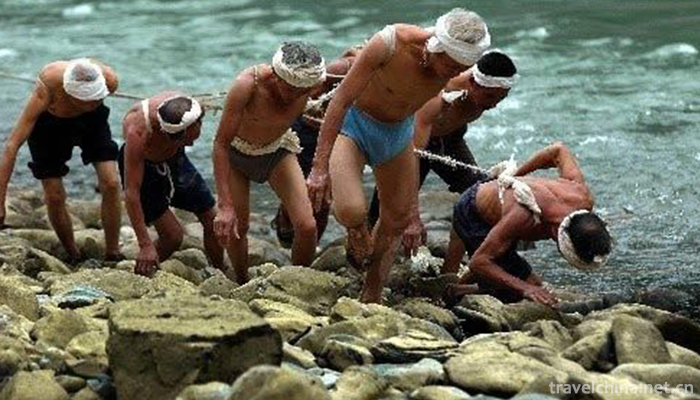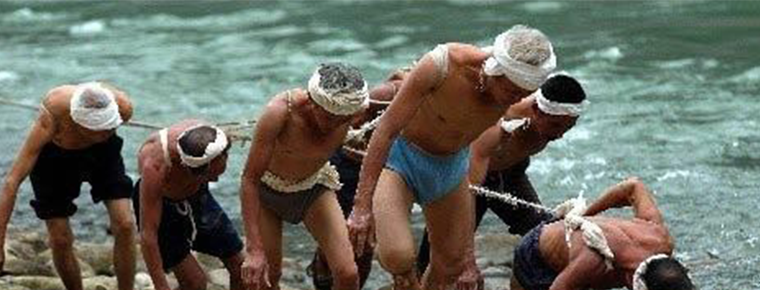River chant
River chant
River chant is a traditional folk song spread in the Yellow River and the Yangtze River valley. In ancient times, when people were fighting with nature, they shouted; when harvesting, they happily knocked on stones and sticks, and gave out cheers and singing sounds, forming the "embryonic" of the earliest folk song, the labor chant. The slogan originates from and serves labor. It is not only the tool of labor, but also the eulogy of labor. Its cultural connotation and social function are obvious. Some slogans express the complex feelings of workers, some reflect the characteristics of geographical environment, and some describe folk customs.
On June 7, 2008, Jianghe Channel was approved by the State Council to be included in the second batch of national intangible cultural heritage lists.
brief introduction
The singing way of the chant is mainly "collar, close" type, that is, one person leads, all people gather; or all people lead, all people gather. In the slower pace of labor, the "collar" sentence is longer and the "combination" sentence is shorter. In the more tense labors, the leading and closing sentences are short in divination. In addition, in most cases, after the lead sentence is sung, the chorus is sung again, but there are also choruses entered before the end of the lead sentence, thus the two voices form an overlapping state.
historical origin
The unique charm of the chant has had a brilliant page in the history of modern music in China. For example, in the Yellow River Chorus, which was born during the Anti-Japanese War, the first movement "Yellow River Boatman's Song" adopted the form of labor chant. Its distinctive national style, strong breath of life and artistic appeal greatly stimulated the national spirit. In recent years, "Chuanjiang Chant" and "Yellow River Chant" have been listed in the national intangible cultural heritage list by the State Council to protect and inherit.
The Yellow River horn belongs to a kind of labor horn. Our ancestors cooperated with each other in the struggle against floods, and gradually formed a certain rhythm, a certain regularity and a certain undulating sound (horn). The Yellow River horn was born in the sound of our ancestors "Hey, Hey, Hey".
In the course of harnessing the Yellow River, there are different types of work, and the number of the Yellow River is also divided into many categories, such as emergency call, ramming call, boatman call, earth call, tie pillow and push pillow call, and so on. There are different schools in different regions, and all kinds of call are colorful and contentious.
According to the Record of Song Shi Hequ, "Where hundreds or thousands of people use Dingfu to sing in chorus, they accumulate in humble places, which is called"chorus". This kind of"chorus"is the chant.
Representative works
The Yellow River emergency trumpet, Tujia trumpet and so on.
Inheritance significance
A good slogan of the Yellow River, with healthy content, fresh style, elegant words and sentences, passed down from generation to generation, is deeply loved by the masses. Especially since the founding of New China, the content of the Yellow River slogan is more abundant and healthy. It's not only singing and smoothing, but also full of literary color. It is more valuable to integrate the significance of Yellow River control work, how to ensure the quality and standard of the project, the attitude of the owner and the construction status into the Yellow River slogan. It has become a good textbook for self-compiling, self-shouting, self-pleasure and self-education of the masses and a true record of its construction. For example, there is a sentence in a blockbuster's slogan: "The sun rolls down the West hill, birds throw trees and tigers back to the mountain." All the traveling guests live in hotels, and thousands of families close their doors. In the era of sunrise and sunset, thousands of families closed their doors and rested. Only ten thousand horses on the construction site of Yellow River Control reflect objectively the great hardship of Yellow River Control. The rhyme of the Yellow River horn is beautiful, the construction site is hot, the singing is tremendous, outsiders are also happy to appreciate. On the village road near the construction site, from time to time, children's Milky singing: "Hey, hey, hey", shows its strong appeal.


-
1.Jingpo Lake
Jingbo Lake: National AAAAA-level tourist attractions, World Geopark, National Key Scenic Spots, International Ecotourism Resort, National Civilized Scenic Spots Demonstration Sites
Time 2018-12-05 -
2.Mount Maoshan
Maoshan is located in Jurong City, Zhenjiang City, Jiangsu Province. It is about 10 kilometers long from north to south, 5 kilometers wide from east to west, and covers an area of more than 50 square
Time 2018-12-06 -
3.Tengchong Volcanic Hot Sea Tourist Area
The volcanic hot sea is located 20 kilometers southwest of Tengchong County. It covers an area of 9 square kilometers. There are more than 80 large gas springs and hot springs. Among them
Time 2018-12-12 -
4.JiuMenKou Great WallTime 2018-12-22
-
5.White Deer hot spring bailu hot spring
Bailu Hot Spring is a hot spring resort center built according to the national AAAA scenic standard. Located in Wentang Town, Pingshan County, Shijiazhuang City, Hebei Province, Bailu Hot Spring is a
Time 2019-01-02 -
6.The Yellow Dragon Cave huanglong Cave
Located in Wulingyuan Scenic Area, the core scenic spot of Zhangjiajie City, Hunan Province, Huanglong Cave is an integral part of the World Natural Heritage Site and Zhangjiajie World Geopark
Time 2019-01-18 -
7.Shaanxi History Museum
Shaanxi History Museum, China's first large-scale modern national museum, the first batch of China's "AAAA" class tourist attractions, known as the "ancient capital pearl,
Time 2019-02-08 -
8.Tanggu Dagukou Battery Site Museum
Dagukou Battery Site Museum is located on both sides of the Haihe River estuary in the southeast of Tanggu, Tianjin Binhai New Area. It is a national education and youth education
Time 2019-02-13 -
9.Sichuan Opera
Sichuan Opera, commonly known as Sichuan Opera, is mainly popular in the Han nationality areas of Sichuan, Chongqing, Yunnan and Guizhou provinces in southwestern China
Time 2019-04-19 -
10.Ming style Furniture Making Skills
Ming-style furniture production techniques began in the Five Dynasties, after the Song Dynasty, including Liao and Jin Dynasties. In the Ming Dynasty, it reached a brilliant peak and developed into di
Time 2019-06-05 -
11.Firing Techniques of Copper Official Ceramics in Changsha Kiln
Changsha kiln copper official ceramics firing technology, Hunan Province's traditional handicraft, one of the national intangible cultural heritage.
Time 2019-07-25 -
12.North China University of Technology
North Polytechnic University was founded in 1946. Its predecessor was the National Beiping Advanced Industrial Vocational School. It was renamed Northern Polytechnic University in 1985 and has been ma
Time 2019-09-06